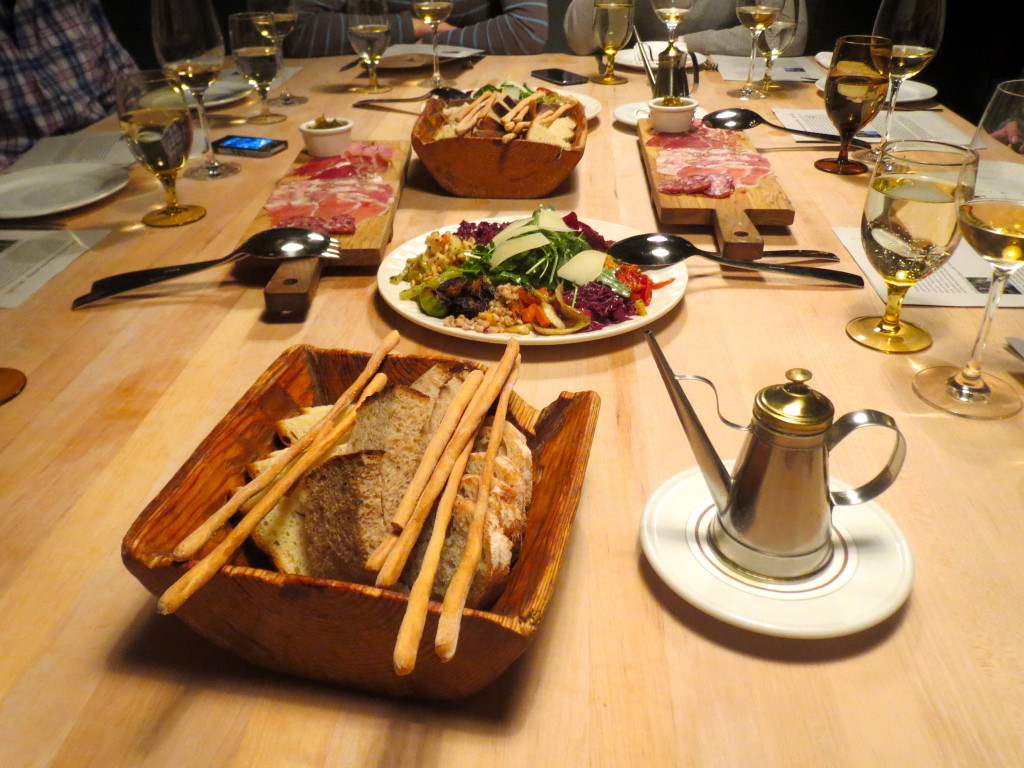Osteria Macerated Wines Class

I recently attended Osteria’s “Macerated Wines: Beyond Red and White” class, which is part of a greater wine series in the recent Osteria culinary course offerings. At $35, the two hour course is a great value. We tasted five different wines, while munching on a delicious house cured salumi plate, served with a sweet artichoke mostarda; fresh bread paired with incredible quality olive oil; and simple, yet tasty, vegetables–ranging from brussel sprouts with pancetta to sea salt-roasted beets.
While the food may have been delicious, the wines, of course, were the stars of the evening. We began by tasting a 2008 Sauvignon white wine, Simcic, from Slovenia. This was a white wine that had a deep honey-like color. The taste reminded me more of a red than a white, as it was a lot more full-bodied that a traditional white wine. We next tasted a much lighter 2009 Pinot Grigio, Scarbolo, from Friuli, Italy. This wine was reminiscent of a traditional Pinot, with both a refreshing smell and taste.
It is now that I must delve into what exactly is meant by macerated wines, because from this point in the class forward, the wines took a turn for the interesting. Macerating refers to the process of letting the grapes steep, sometimes with skin and stems–depending on the desired outcome. The first wine had been macerated for about 5-7 days, accounting for its fuller flavor. As a fan of red wines, I enjoyed this.
For the third wine, we went to a whole new place: the “orange wine” movement. For those unfamiliar, as I was prior to this class, the “orange wine” movement refers to wine preparation that returns to traditional methods. Think like an organic farm x 10. The winery is entirely self-sustained, and producers often make use of the natural elements to flavor their wines. For example, they may plant something in particular to attract certain insects. They may also allow the wine to interact with the the elements fully–even going so far as to allow them to oxidize in the process! This was the case with the third wine we tried, a Radikon, 2009 Pinot Grigio from Friui, Italy. This wine saw a full two weeks of open top heavy maceration, leading to a very distinct flavor. As the name suggests, the wine itself was “orange” and also unfiltered. The taste was entirely distinct, and would definitely be a conversation starter at a dinner party. The instructor informed us that the wine was so fully oxidized prior to bottling, that an open bottle–uncorked–could remain drinkable for almost three weeks! Personally, this wine was a bit too foreign for me to enjoy, so I couldn’t imagine myself actually finishing an entirely glass of it. However, the other orange wine we tried, a 2009 Slatnik Radikon from Friui, Italy, did pass by palate’s test. It had a sweet fruity aroma and a caramel color. The wine saw 4 full weeks of maceration–quite a lot in comparison to that first wine–and the wine was fully exposed to the elements. Well, whatever it is the elements are doing, I’m into it.
We also tried a 2005 Rioja Crianza, which was a delicious full-bodied red. There was nothing surprising about the fact that I enjoyed this wine. I know I like my full-bodied reds, and I know I like my Riojas!
Overall, the class was a blast; there was a diverse range of previous knowledge about wine, and a good rapport developed amongst the class. It was informative, yet fun. I was able to ask a ton of questions, which was probably my favorite part. My least favorite part? These wines are all unique. So it won’t be as easy as wandering into the back room of Osteria to get myself a glass!
Chelsea Goldinger
